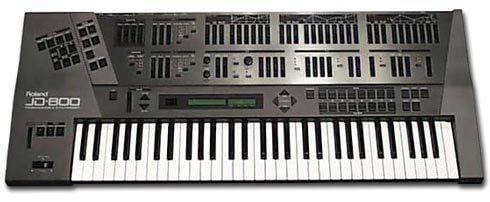Price US$2,895UK£1,699 | Dates 1991-1996 | |
 | ||
Polyphony 24 voices using 1 tone6 voices using 4 tones Timbrality 5 + 1 drum part (61 note assignable) Oscillator 3MB of PCM ROM with 108 waveforms + 1MB expansion | ||
The Roland JD-800 is a digital synthesizer that was manufactured between 1991 and 1996. The synthesizer features many knobs and sliders for patch editing and performance control – features that some manufacturers, including Roland, had been omitting in the name of "streamlining" since the inception of the Yamaha DX7. The JD-800 thus became very popular with musicians who wished to take a "hands on" approach to patch programming. In the introduction to the manual, it is stated that Roland's intention with the JD-800 was to "return to the roots of synthesis".
Contents
Technology
The JD-800 combines sample playback with digital synthesis, a process that Roland calls Linear Arithmetic synthesis, a technique Roland had been using to great effect in the Roland D-50. The JD-800 has 108 waveforms built-in, but these can be expanded via PCM-cards. There are waveforms in a variety of categories, like; analog synth, acoustic instruments, like guitars, woodwind, brass and voices. Most of these waveforms are very short and are designed to give character to the attack portion of a sound, while some longer ones are designed for creating pads, or the sustained part of a patch. The JD-800 was the first instrument from Roland to have its core sound set of waveforms developed entirely in the United States, under a short-lived branch of Roland's R&D-LA office in Culver City, California. The core sampled waveforms and Factory presets of the JD-800 were created by Eric Persing.
A patch, or single sound, in the JD-800 consists of up to 4 tones. As every tone consists of an almost completely independent synthesizer voice a patch could be considered a layer of up to 4 different synthesizers. In single mode the JD-800 plays one patch at a time, but in multi mode it is possible to play 5 different patches, over MIDI, plus an extra "special" patch. The special patch has different waveforms assigned to the 61 different key on the keyboard, so is used for drums and percussion sounds. The JD-800 has one effects section. In single mode 7 effects can be used simultaneously, in series, so all tones in a patch go through the same effects. In multi mode 3 effects can be used at the same time, all patches sharing the same effects, though a patch can be routed to bypass the effects.
Editing and playing
Using the "layer" buttons, the player can switch the 4 tones in a patch on and off, while playing. When in "edit" mode, the layer buttons are used to choose which tones' parameters are changed using the sliders on the front panel. The "palette" sliders allow the player to edit the last active parameter of all 4 tones individually at the same time. While playing, the palette sliders can easily be used like a little mixing board to set the balance between the 4 tones in a patch. Nonetheless, due to the limited accuracy of the sliders, and because edited parameters jump from the value in memory to the value corresponding to the position of the slider, when the slider is moved, it is hard to edit sounds while playing without creating sudden "jumps" in the sound.
The JD-800 manual stated: "[T]he original purpose of the synthesizer was to 'create sound'. It's easy to simply select a preset you like, but that sound will always be 'someone else's sound'. We at Roland asked, 'Why don't we return to the roots of synthesis; the enjoyment of creating original sounds?' ... 'Creating sounds' may seem like a highly technical process, but it's actually just a matter of moving a slider to make the sound change! This is easy for anyone, and the sounds that you get will always be your very own."
JD-990
Roland released the JD-990 Super JD in 1993. This is an enhanced rackmountable sound module version of the JD-800, without sliders, a larger display, and the ability to expand the device with PCM cards for extra sounds.
Expandability
The synth was expandable by the inclusion of slots for PCM and RAM cards. The former increased the number of waveforms available to the user, the latter increased the number of patches that could be used. Roland produced a number of expansion kits for the synth (and other compatible models) comprising a pair of cards - a PCM card containing new samples, and a RAM card containing a bank of new presets.
PCM add on cards:
Roland later released 8 add on cards for the JD 800:
- SL-JD80-01 Drums & Percussion STANDARD
- SL-JD80-02 Drums & Percussion DANCE
- SL-JD80-03 Rock Drums
- SL-JD80-04 Strings Ensemble
- SL-JD80-05 Brass Section
- SL-JD80-06 Grand Piano
- SL-JD80-07 Guitar Collection
- SL-JD80-08 Accordion
